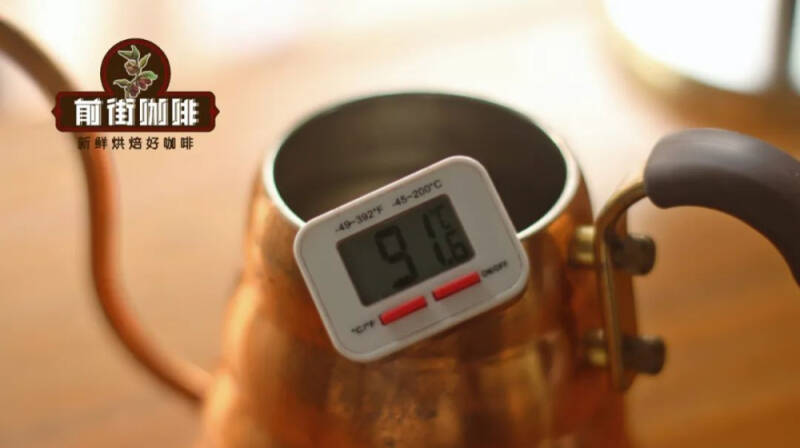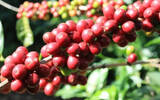Is there a big difference between coffee brewed with 91 ℃ and 93 ℃?

A friend once wrote a private message in front of the street backstage: "is the temperature of the cooking water you suggest 91 ℃ or 93 ℃? will there be a big difference in taste when these two or three times come out?"
Familiar friends may know that when sharing coffee extraction parameters in Qianjie, the water temperature is often a range rather than an accurate number. For example, this range is 91 ℃ ~ 93 ℃ for light roasted coffee beans and 86 ℃ ~ 88 ℃ for deep roasted coffee beans.

Does it mean that all the temperatures in this range can be used? There is a difference of two or three degrees between the highest and the lowest temperature in this range. Will there be a big difference in the coffee brewed out? It's not too late. Come to the experiment and compare it right away.
In this experiment, two groups were compared and discussed, and the minimum and maximum recommended water temperature were selected to brew a shallow baked bean (91 ℃ and 93 ℃) and a deep baked bean (86 ℃ and 88 ℃), respectively, for a total of four pots of coffee. Shallow baking chooses Yega Xuefei of Ethiopian Guoding processing Plant, and Deep Baking is the Queen's Manor of Brazil.
Fruit Ding Ding (shallow baking) cooking parameters: powder quantity: 15g; ratio of water to powder: 1: 15; grindability: 80% pass rate of No. 20 sieve (ek43s 10 grid); V60 filter cup; three-stage cooking technique.
Brazilian Queen Manor (deep baking) cooking parameters: powder quantity: 15g; ratio of water to powder: 1: 15; grindability: 75% pass rate of No. 20 sieve (ek43s 10.5grid); kono filter cup; three-stage cooking method.
Separately sample and test the concentration of four cups of coffee to calculate the extraction rate: light roasting (fruit dingding) concentration extraction rate 91 ℃ 1.32% 18.13% 93 ℃ 1.36% 18.69% deep roasting (Queen's Manor)
86 ℃ 1.39% 19.11% 88 ℃ 1.44% 19.81% from the data, the maximum water temperature is 0.04% (light baking) and 0.05% (deep baking) higher than the minimum water temperature concentration, respectively, increasing the extraction rate of 0.56% (shallow baking) and 0.7% (deep baking), respectively. After reading the data, let's taste and compare the flavor characteristics of the two groups.
First of all, the light roasted (fruit Ding Ding) group, 91 ℃ and 93 ℃ two cups of coffee, showing a similar citrus flavor, soft lemon acidity; the difference is that the 93 ℃ cup will be a little more sweet, more layered and more tea-like.
In the deep roasting (Queen's Manor) group, both cups of coffee showed nutty and creamy flavor. The 86 ℃ cup was slightly sour at high temperature, which was more refreshing than 88 ℃, while 88 ℃ was mellow and sweeter, but relatively smoky at high temperature.
This is because the higher the water temperature is, the easier it is to extract the flavor substances in the coffee, that is, the more the water temperature increases, the faster the soluble substances dissolve (sugar dissolved at different water temperatures is a good example). At the same time, the increase of temperature will also make the flavor substances more active, thus the extraction efficiency will be improved.
Therefore, Qianjie will choose the water temperature of 91 ℃ when cooking most of the medium and shallow roasted coffee beans. Under the same parameters, this can greatly reduce the occurrence of accidents and ensure the stability of the products. But this is not absolute, daily production also found that under the same extraction parameters, cooking Kenyan coffee beans at a water temperature of 93 ℃ can show a richer flavor and solid acidity.
When deep-roasted coffee beans such as Indonesia Mantenin, Blue Mountain and Queen of Brazil show mellow taste and charm, Qianjie is not recommended to use too "radical" temperature. The water temperature of 86 ℃ ~ 88 ℃ can make the coffee more mild, the bitterness is not so easy to extract, and does not make people put on a "pain mask".
-END-
Front Street Cafe
No. 10 Baoqian street, Yandun road, Dongshankou, Yuexiu district, Guangzhou, Guangdong province
Important Notice :
前街咖啡 FrontStreet Coffee has moved to new addredd:
FrontStreet Coffee Address: 315,Donghua East Road,GuangZhou
Tel:020 38364473
- Prev

Bourbon coffee bean derivative species: introduction of Kaddura, Verasac, Pacas and bourbon Mayaguis
Bourbon Bourbon is one of the most culturally and genetically important Arabica varieties of coffee, famous for its high altitude and excellent quality. But the yield of bourbon is relatively low and is susceptible to major diseases of coffee plants, so it is currently in Latin America by some derived varieties (Kadu).
- Next

Can the bean grinder be washed with water? How to clean and maintain hand bean grinder electric bean grinder?
Last week, Qianjie summed up nine small details to pay attention to when making coffee, including the importance of regular cleaning and maintenance of the bean grinder, so a curious baby asked: can the bean grinder be washed? Before answering this question, it is necessary for us to find out why the bean grinder is cleaned. On the market
Related
- What ratio of water temperature and ground does the smart cup method use to press coffee? The difference between brewed coffee and filtered coffee?
- What is the standard process for the purpose of coffee cup testing? What is the difference between hand-brewed coffee and cup testing?
- How to use hand-brewed coffee paragon small golden balls? How does cold coffee lock in the aroma of coffee?
- Is American coffee black? What is the difference between American coffee and drip coffee?
- Unexpected! Well-known tea beverage brand Lele Tea will withdraw from the Zhengzhou market!
- Starbucks enters the fashion and beauty industry?! Netizen: Give me an ice American eye cream
- Why can American refills for free? The difference between Americano and American drip pot coffee
- Being chased out of the rain in front of Starbucks?! Store: Sheltering from rain under umbrellas poses a safety hazard
- The white moonlight has changed?! Lucky launches "Big Winter Pear American"
- Hand-brewed coffee three-stage method, high-sweet and universal brewing method to share! What does the high sweet water level of hand-brewed coffee mean?

